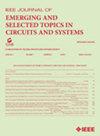Learned Image Compression With Efficient Cross-Platform Entropy Coding
IF 3.8
2区 工程技术
Q2 ENGINEERING, ELECTRICAL & ELECTRONIC
IEEE Journal on Emerging and Selected Topics in Circuits and Systems
Pub Date : 2025-02-04
DOI:10.1109/JETCAS.2025.3538652
引用次数: 0
Abstract
Learned image compression has shown remarkable compression efficiency gain over the traditional image compression solutions, which is partially attributed to the learned entropy models and the adopted entropy coding engine. However, the inference of the entropy models and the sequential nature of the entropy coding both incur high time complexity. Meanwhile, the neural network-based entropy models usually involve floating-point computations, which incur inconsistent probability estimation and decoding failure in different platforms. We address these limitations by introducing an efficient and cross-platform entropy coding method, chain coding-based latent compression (CC-LC), into learned image compression. First, we leverage the classic chain coding and carefully design a block-based entropy coding procedure, significantly reducing the number of coding symbols and thus the coding time. Second, since CC-LC is not based on neural networks, we propose a rate estimation network as a surrogate of CC-LC during the end-to-end training. Third, we alternately train the analysis/synthesis networks and the rate estimation network for the rate-distortion optimization, making the learned latent fit CC-LC. Experimental results show that our method achieves much lower time complexity than the other learned image compression methods, ensures cross-platform consistency, and has comparable compression efficiency with BPG. Our code and models are publicly available at学习图像压缩与高效的跨平台熵编码
与传统的图像压缩方案相比,学习图像压缩显示出显著的压缩效率提高,这部分归功于学习熵模型和所采用的熵编码引擎。然而,熵模型的推断性和熵编码的时序性都会导致较高的时间复杂度。同时,基于神经网络的熵模型通常涉及浮点计算,在不同的平台上导致概率估计不一致和解码失败。我们通过在学习图像压缩中引入一种高效的跨平台熵编码方法,基于链编码的潜在压缩(CC-LC)来解决这些限制。首先,我们利用经典的链编码,精心设计了基于块的熵编码过程,显著减少了编码符号的数量,从而缩短了编码时间。其次,由于CC-LC不是基于神经网络,我们提出了一个速率估计网络作为端到端训练CC-LC的替代品。第三,我们交替训练速率失真优化的分析/综合网络和速率估计网络,使学习到的潜在拟合CC-LC。实验结果表明,该方法的时间复杂度远低于其他已学习的图像压缩方法,并保证了跨平台的一致性,压缩效率与BPG相当。我们的代码和模型可以在https://github.com/Yang-Runyu/CC-LC上公开获得。
本文章由计算机程序翻译,如有差异,请以英文原文为准。
求助全文
约1分钟内获得全文
求助全文
来源期刊

IEEE Journal on Emerging and Selected Topics in Circuits and Systems
ENGINEERING, ELECTRICAL & ELECTRONIC-
CiteScore
8.50
自引率
2.20%
发文量
86
期刊介绍:
The IEEE Journal on Emerging and Selected Topics in Circuits and Systems is published quarterly and solicits, with particular emphasis on emerging areas, special issues on topics that cover the entire scope of the IEEE Circuits and Systems (CAS) Society, namely the theory, analysis, design, tools, and implementation of circuits and systems, spanning their theoretical foundations, applications, and architectures for signal and information processing.
 求助内容:
求助内容: 应助结果提醒方式:
应助结果提醒方式:


